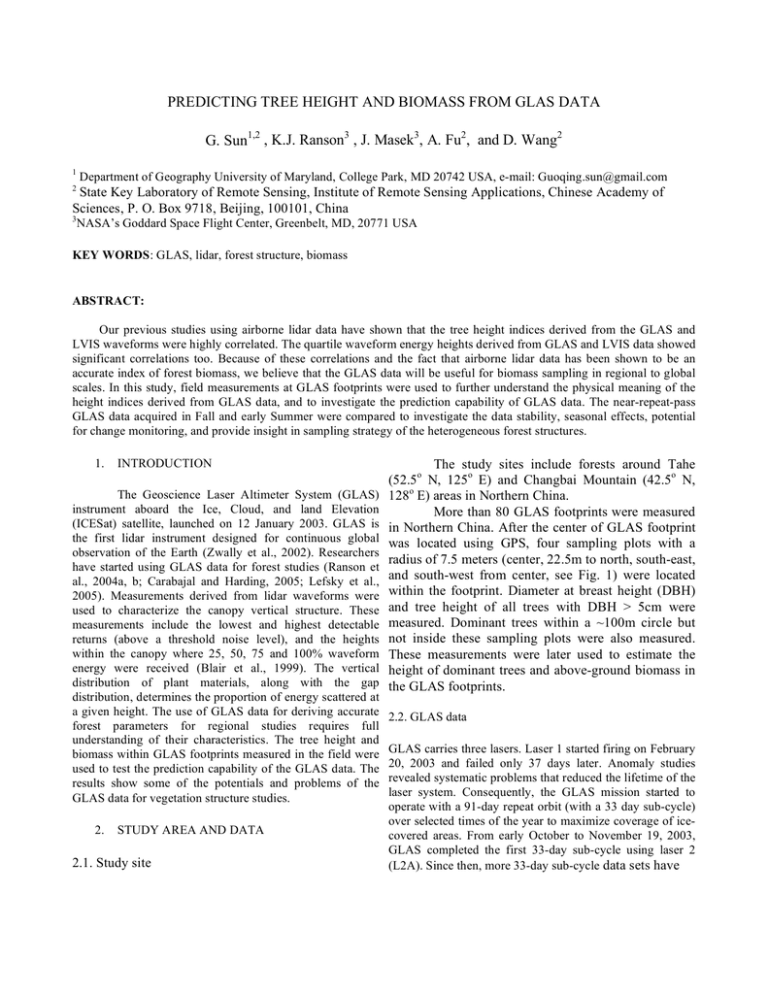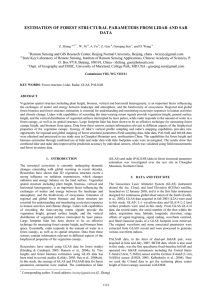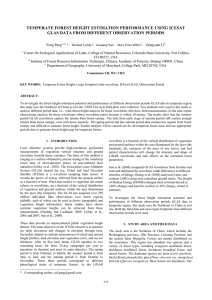PREDICTING TREE HEIGHT AND BIOMASS FROM GLAS DATA G. Sun
advertisement

PREDICTING TREE HEIGHT AND BIOMASS FROM GLAS DATA G. Sun1,2 , K.J. Ranson3 , J. Masek3, A. Fu2, and D. Wang2 1 Department of Geography University of Maryland, College Park, MD 20742 USA, e-mail: Guoqing.sun@gmail.com 2 State Key Laboratory of Remote Sensing, Institute of Remote Sensing Applications, Chinese Academy of Sciences, P. O. Box 9718, Beijing, 100101, China 3 NASA’s Goddard Space Flight Center, Greenbelt, MD, 20771 USA KEY WORDS: GLAS, lidar, forest structure, biomass ABSTRACT: Our previous studies using airborne lidar data have shown that the tree height indices derived from the GLAS and LVIS waveforms were highly correlated. The quartile waveform energy heights derived from GLAS and LVIS data showed significant correlations too. Because of these correlations and the fact that airborne lidar data has been shown to be an accurate index of forest biomass, we believe that the GLAS data will be useful for biomass sampling in regional to global scales. In this study, field measurements at GLAS footprints were used to further understand the physical meaning of the height indices derived from GLAS data, and to investigate the prediction capability of GLAS data. The near-repeat-pass GLAS data acquired in Fall and early Summer were compared to investigate the data stability, seasonal effects, potential for change monitoring, and provide insight in sampling strategy of the heterogeneous forest structures. 1. INTRODUCTION The Geoscience Laser Altimeter System (GLAS) instrument aboard the Ice, Cloud, and land Elevation (ICESat) satellite, launched on 12 January 2003. GLAS is the first lidar instrument designed for continuous global observation of the Earth (Zwally et al., 2002). Researchers have started using GLAS data for forest studies (Ranson et al., 2004a, b; Carabajal and Harding, 2005; Lefsky et al., 2005). Measurements derived from lidar waveforms were used to characterize the canopy vertical structure. These measurements include the lowest and highest detectable returns (above a threshold noise level), and the heights within the canopy where 25, 50, 75 and 100% waveform energy were received (Blair et al., 1999). The vertical distribution of plant materials, along with the gap distribution, determines the proportion of energy scattered at a given height. The use of GLAS data for deriving accurate forest parameters for regional studies requires full understanding of their characteristics. The tree height and biomass within GLAS footprints measured in the field were used to test the prediction capability of the GLAS data. The results show some of the potentials and problems of the GLAS data for vegetation structure studies. 2. STUDY AREA AND DATA 2.1. Study site The study sites include forests around Tahe (52.5o N, 125o E) and Changbai Mountain (42.5o N, 128o E) areas in Northern China. More than 80 GLAS footprints were measured in Northern China. After the center of GLAS footprint was located using GPS, four sampling plots with a radius of 7.5 meters (center, 22.5m to north, south-east, and south-west from center, see Fig. 1) were located within the footprint. Diameter at breast height (DBH) and tree height of all trees with DBH > 5cm were measured. Dominant trees within a ~100m circle but not inside these sampling plots were also measured. These measurements were later used to estimate the height of dominant trees and above-ground biomass in the GLAS footprints. 2.2. GLAS data GLAS carries three lasers. Laser 1 started firing on February 20, 2003 and failed only 37 days later. Anomaly studies revealed systematic problems that reduced the lifetime of the laser system. Consequently, the GLAS mission started to operate with a 91-day repeat orbit (with a 33 day sub-cycle) over selected times of the year to maximize coverage of icecovered areas. From early October to November 19, 2003, GLAS completed the first 33-day sub-cycle using laser 2 (L2A). Since then, more 33-day sub-cycle data sets have ground is from surface reflection, the distance from the signal beginning and this ground peak is the top canopy height (referred to as H14). This works only for flat area, and requires significant energy return from ground surface. For cases with dense canopies, rough surfaces with slopes, the elevation of the ground peak becomes questionable. 3. GLAS DATA PROCESSING The GLA14 data were first retrieved along with the record index, the serial number of the shot within the index (from 1 to 40), acquisition time, latitude, longitude, elevation, range offsets of signal beginning, signal ending, waveform centroid, and fitted Gaussian peaks. In the GLA01 data file, the 40 shots received in one-second are assigned only one estimated latitude and longitude. Using the record Fig. 1. Sampling plots within a GLAS footprint: Radius of index and shot number found in GLA14 data, the individual sampling plots (small circle) is 7.5m. The distance between waveform was extracted from GLA01 data along with other sampling plots is 22.5m. parameters such as estimated noise level, noise standard deviation, and transmitted pulse waveform, which were used been acquired in Feb-March, May-June and October- later in waveform processing. November periods each year. The use of laser 3 was initiated in October, 2004 (L3A), and continued in February-March A method for calculating the heights of (L3B), May-June (L3C), October-November (L3D) in 2005, quartile waveform energy from GLAS waveform was and Feb-March (L3E), May-June (L3F) in 2006. These 33- implemented. A Gaussian filter with a width similar to the day sub-cycles are nearly repeat-passes of the October- transmitted laser pulse was used to smooth the waveform. November 2003 data (L2A), providing a capability for For many cases, the noise level before the signal beginning seasonal and inter-annual change monitoring. GLAS data was lower than the noise after the signal ending. from L2A, L3A, L3C, L3D and L3F were used in this study. Consequently, we estimated the noise levels before the signal beginning and after the signal ending from the GLAS uses 1064-nm laser pulses and records the original waveform separately using a method based on the returned laser energy from an ellipsoidal footprint. The histogram. Using three standard deviations as a threshold footprint diameter is about 65m, but its size and ellipticity above the noise level, the signal beginning and ending were have varied through the course of the mission (Schutz et al, located. The total waveform energy was calculated by 2005; Abshire et al., 2005). GLA01 products provide the summing all the return energy from signal beginning to waveforms for each laser shot, but only an estimated ending. Starting from the signal ending, the position of the geolocation for all 40 shots acquired within 1 second. For 25%, 50%, and 75% of energy were located by comparing the land surfaces, the waveform has 544 bins with a bin size the accumulated energy with total energy. Since the heights of 1-nsec or 15cm. The bin size from bin 1 to 151 has been of these quartiles refer to the ground surface, not the signal changed to 60cm starting from acquisition L3A, so the total ending, the ground peak in the waveform needs to be waveform length increased from 81.6m to about 150m. The located. Searching backward from the signal ending, the product GLA14 (Land/Canopy Elevation) doesn’t contain peaks can be found by comparing a bin’s value with those of the waveform, but various parameters derived from the the two neighboring bins. If the first peak is too close to the waveform. The GLAS waveforms were smoothed using signal ending, i.e. the distance from signal ending to the filters, and the signal beginning and end were identified by a peak is less than the half width of the transmitted laser pulse, noise threshold. The smoothed waveform was initially fitted this peak was discarded. The first significant peak found is using many Gaussian peaks at different heights, and then the the ground peak. As terrain slope and surface roughness peaks were reduced to six by an iterative process (Zwally et increase, the ground peak of the waveform becomes wider al., 2002; Harding and Carabajal. 2005). GLAS14 data and the signal beginning moves upwards in a proportional provides the surface elevation and the laser range offsets for manner. The distance between the signal ending and the the signal beginning and end, the location, amplitude, and assumed signal ending when the surface is flat was used as width of the six Gaussian peaks. Fig. 2 shows a GLAS an adjustment to the signal beginning. waveform from our study area with the Gaussian peaks 4. PREDICTION OF TREE HEIGHT AND (Hofton et al., 2000) and other parameters extracted from BIOMASS FROM GLAS DATA GLA14 data products. Assuming that the last peak near the The field measurements and the processed GLAS data were used to train a neural network for prediction of tree height and stand biomass. Fig. 2 shows the correlation between field biomass measurements and the biomass predicted by a trained neural network model from GLAS indices. The model used six input variables derived from total length of waveform, top canopy height, 25% and 75% waveform quartiles, with 10 nodes in a hidden layer. Fig. 3. shows the correlation between field maximum tree height measurements and the height predicted by a trained neural network model from GLAS indices. The model used 5 input variables derived from total length of waveform, quadratic mean canopy height, 25% and 50% waveform quartiles, with 3 nodes in a hidden layer. These neural models then were applied to all GLAS footprints acquired in Fall, 2003. The statistics of tree height and stand biomass within an area of 38o to 50o N, 120o to 130o E were calculated for major forest classes, and disturbed areas. Fig. 4 and 5 show the histograms f tree height and biomass in this region. Table 1 is a list of average tree height and biomass for various forest classes in the region. Fig. 3. Prediction of top tree height from GLAS data. Fig. 4. Histogram of biomass in the region (min. = 6.42, max. = 427.41). Peak at < 20Mt/ha is non-forest area. Fig. 2. Prediction of stand biomass from GLAS data. Fig. 5. Histogram of tree height in the region (min. = 2.5m, max. = 24.14m). The peak at ~4m is non-forest area. Table 1. Average tree height and biomass for different forest types in a region of 38o – 50o N, 120o – 130o E, estimated from GLAS data. ENC – Evergreen Needle Conifer, DNC – Deciduous Needle Conifer, DB1-3 – Deciduous Broadleaf, Mix1-3 – Mixed Forests, Bn1-2 – disturbed (burned) forests. Height (m) Biomass (kg/m2) ENC 13.33 DNC 13.96 DB1 14.12 DB2 13.79 DB3 12.02 Mix1 14.53 Mix2 14.45 Mix3 14.27 Bn1 8.85 14.93 10.72 10.18 8.67 6.44 13.75 10.96 11.77 3.75 Blair, J. B., D. L. Rabine, M. A.and Hofton, (1999): The laser vegetation imaging sensor (LVIS): a mediumaltitude, digitations-only, airborne laser altimeter for mapping vegetation and topography, ISPRS Journal of Photogrammetry and Remote Sensing 54: 115-122. Bn2 8.98 Carabajal, C. C., and D. J. Harding, (2005): ICESat Validation of SRTM C-Band Digital Elevation 4.17 Models, Geophys. Res. Lett., 33, L22S01. There were total 174,553 GLAS footprints in this 12o by 10o Hofton, MA; Minster, JB; Blair, JB., (2000): Decomposition of laser altimeter waveforms. Ieee Transactions On area. 63,906 samples were in forested area (36.6% forest Geoscience And Remote Sensing 38 (4): 1989-1996, cover). Both the tree height and biomass values are Part 2. reasonable. In the disturbed area (mainly by fire), tree height is shorter, ad biomass is lower. These results will be Lefsky, MA, David J. Harding, Michael Keller, Warren B. compared with data from other resources in future studies. Cohen, Claudia C. Carabajal, Fernando Del Bom Espirito-Santo, Maria O. Hunter, and Raimundo de Oliveira Jr.(2005): Estimates of forest canopy 5. CONCLUSIONS height and aboveground biomass using ICESat, Geophysical Research Letters, VOL. 32, L22S02, The Geoscience Laser Altimeter System (GLAS) is doi:10.1029/2005GL023971, 2005. the first lidar instrument for continuous global observation of the Earth. Field measurements were mainly conducted at flat areas or with small slopes. The study showed that for Ranson, K. J., G. Sun, K. Kovacs, and V. I. Kharuk, (2004a): Landcover attributes from ICESat GLAs these cases GLAS waveform data provides reasonable data in central Siberia, IGARSS 2004 Proceedings, prediction for the heights of dominant trees and above20-24 September 2004, Anchorage, Alaska, USA. ground biomass. The study also shows that GLAS samples provides a reasonable statistics on biomass level, forest coverage but further studies area needed to evaluate the Ranson, K. J., G. Sun, K. Kovacs, and V. I. Kharuk, terrain effects, seasonal variation of GLAS samples, etc. (2004b): Use of ICESat GLAS data for forest disturbance studies in central Siberia, IGARSS 2004 Proceedings, 20-24 September 2004, Anchorage, 6. ACKNOWLEDGEMENT Alaska, USA. This study and field work was funded by National Science Foundation of China (40571112), the 863 program Schutz, B. E., H. J. Zwally, C. A. shuman, D. Hancock, and J. P. DiMarzio, (2005): Overview of the ICESat (2006AA12Z114) of China, and NASA’s Science Mission Mission, Geophysical Research Letters 32 (22). Directorate. 7. REFERENCES Abshire, J. B., X. Sun, H. Riris, J. M. Sirota, J. F. McGarry, S. Palm, D. Yi, and P. Liiva, (2005): Geoscience Laser Altimeter System (GLAS) on the ICESat Mission: On-orbit measurement performance, Geophysical Research Letters 32 (22). Zwally H.J., B. Schutz, W. Abdalati, , J. Abshire, C. Bentley, A. Brenner, J. Bufton, J. Dezio, D. Hancock, D. Harding, T. Herring, B. Minster, K. Quinn, S. Palm, J. Spinhirne, R. Thomas, (2002): ICESat's laser measurements of polar ice, atmosphere, ocean, and land. Journal of Geodynamics 34 (3-4): 405-445.






